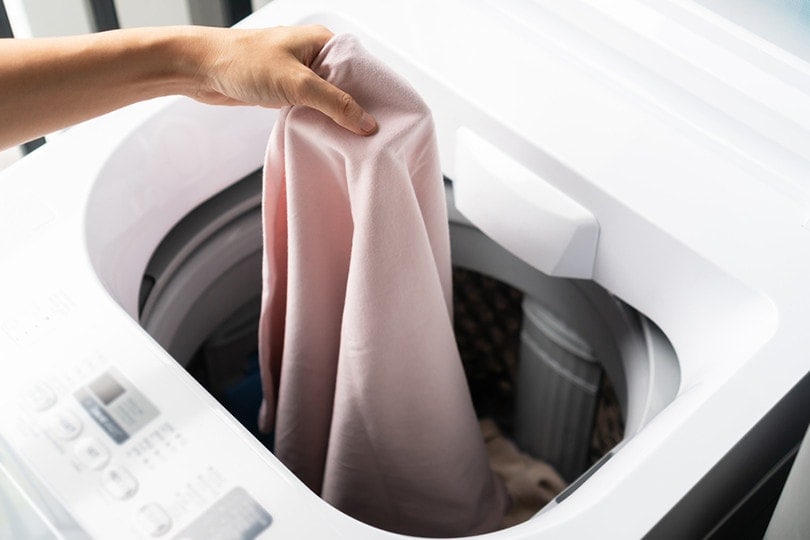
Click to Skip Ahead
A single-celled organism called Giardia could potentially be the reason your pet is experiencing weight loss and diarrhea. Due to its prevalence in the environment, it is important to try to reduce the chances of Giardia exposure to your pet. If your pet does develop giardiasis from an infection with Giardia, it is fortunately treatable with guidance and medication from your veterinarian. Continue reading to learn more about this potentially harmful protozoan.
What Is Giardia?
Giardia is a type of single-celled organism called a protozoan. There are several different species of Giardia, and not every variety causes infection in dogs. The protozoan can cause illness in exposed animals when the infective stage, called a cyst, is ingested.1
The cyst enters into the host’s gastrointestinal tract where it transforms into the trophozoite stage once the hard cystic shell is destroyed. The trophozoite then divides into two trophozoites through binary fission. The protozoan swims through the gastrointestinal tract by use of long, whip-like tails or flagella.
When the organism finds a suitable place within the intestines, a suction cup-like mouthpiece allows the organism to grip onto the intestines. As Giardia attaches and damages the intestinal lining, absorption abnormalities occur, which results in diarrhea.
As trophozoites head to the rectum, they begin developing into the cystic form, which is the only way the organism will survive in the environment due to the protective covering. Trophozoites that accidentally pass into the stool will die if unable to encyst.
Giardia duodenalis is the species of Giardia that impacts mammals, including humans. Giardia is further classified into assemblages, with assemblages A, C, and D most often impacting dogs. Uncommonly, assemblage B has been isolated in dogs. Depending on the assemblage, giardiasis can be zoonotic, meaning it can be spread from animals to people. Most often, assemblage A and, to a lesser extent, assemblage B can be passed from dogs to humans.

How Did My Dog Get Giardiasis?
Most dogs contract giardiasis through ingestion of infected water. Cysts are able to survive in the environment for months, provided that the environment is hospitable. Fecal consumption and grooming leading to cyst ingestion are other ways that a dog can become infected.
What Are the Signs of Giardiasis?
Most patients do not show clinical signs of infection, and the diagnosis is often incidental. Patients who do have clinical signs may experience:

How Is Giardiasis Diagnosed?
Patients with giardiasis will often present to their veterinarian with signs of ongoing gastrointestinal signs, like diarrhea. Your veterinarian will perform a complete physical examination and recommend diagnostics for your pup, which will likely include fecal parasite tests.
Unfortunately, Giardia can be difficult to pick up on a typical fecal flotation test that is used to identify gastrointestinal parasites like roundworms and whipworms. As a result, when screening for Giardia, a special solution may be used in the fecal test. Alternatively, a direct fecal evaluation under the microscope may reveal Giardia cysts.
An additional beneficial fecal test is an ELISA test that can identify Giardia antigens. This test can be run in clinics or potentially at a reference laboratory. Within minutes, the test can either provide negative or positive results and is generally able to identify more positive cases than other diagnostics.
How Do I Care for a Pet With Giardiasis?
Medications
If your pet has been confirmed to have giardiasis, your veterinarian will discuss different treatment options. There are two common treatment options, both of which require at-home medication administration. Metronidazole and Fenbendazole are two medications most commonly dispensed to treat giardiasis. These medications may be used separately or concurrently.

Bathing
It is important to note that Giardia is sticky in nature and can cling to the fur surrounding your pet’s rectum. When this occurs, dogs are capable of reinfecting themselves while grooming. As a result, it is recommended that your pet is bathed during and at the end of the treatment course.
When you're grooming your own pet, choosing the right pet shampoo is half the battle. We recommend Hepper's Colloidal Oatmeal Pet Shampoo line because the all-natural, pet-safe formula does a great job of cleaning and moisturizing while avoiding irritation and itching. These soothing shampoos feature oatmeal and aloe vera and neither of them contain sulfates, phthalates, dyes, or soaps. Your pet will love this shampoo as much as you do! Now you just have to choose which one your pet will love best. Here’s a quick guide to help you choose the right option for your pet’s next bath!
Hepper Colloidal Oatmeal Pet Shampoo
Hepper Waterless No Rinse Pet Shampoo
Natural Ingredients
Made in USA
Safe for cats & dogs
Soothes dry skin
Waterless, no rinsing required
At Pet Keen, we've admired Hepper for many years, and decided to take a controlling ownership interest so that we could benefit from the outstanding designs of this cool cat company!
Encourage Fluid Intake
Patients battling giardiasis are at risk of dehydration if severe diarrhea is present. It is important to monitor your pet for signs of dehydration, which may include reduced urination, weakness, dry mucous membranes, and lethargy. Try to encourage your pet to consume water. This may be achieved through the frequent offering of fresh water, adding water to food, or supplementing water intake with ice cubes.
Retesting Your Companion
If your dog still has signs of diarrhea after the completion of giardiasis treatment, your pet may need to be retested. ELISA tests are less helpful in this case, as antigens may still be present after the protozoan itself has been eliminated.
Treat The Environment
Giardia is a hearty organism capable of staying alive in hospitable environments for months. As a result, to lessen the chances of reinfection, it is important to dispose of stool quickly. Additionally, allowing contaminated surfaces to dry completely will help kill the cyst. Quaternary ammonia products and boiling water are effective at killing the cyst, whereas common disinfectants are not.
Frequently washing bedding and toys is a helpful way of limiting possible reinfection and transmission of Giardia. Killing cysts in the environment is much more challenging to do, but hot and dry environments will have a harder time supporting cysts.

How Can a Giardia Infection Be Avoided?
Most dogs develop giardiasis after consuming the infective cyst from dirt or water within their environment. Although it is difficult to completely avoid this scenario, keeping your pet on a leash when outdoors can make avoidance easier. Additionally, being mindful of where you walk your pet is helpful, so you may want to avoid heavy canine trafficked areas or areas that are often damp. Try to be cognizant of picking up your dog’s feces as soon as possible to minimize the chance of spreading the pathogen.
Frequently Asked Questions
My dog has been diagnosed with Giardia, can I become infected?
Giardiasis is considered zoonotic in nature, meaning that an affected dog could potentially pass this pathogen on to people if it belonged to the correct assemblage. It is important to practice good hygiene to minimize the chances of infection, although transmission from dogs is uncommon.
Will my dog be able to recover from Giardia or is it life-threatening?
Fortunately, giardia is very treatable and rarely results in death. Patients who do succumb to this illness are generally geriatric, very young, or immunocompromised.

In Conclusion
While the giardia protozoan can cause gastrointestinal complications in our pets, it is fortunately very treatable. Dogs with giardiasis can experience dehydration, watery diarrhea, and may have weight loss. Your veterinarian will be able to help formulate a plan to help you cure your pet of this protozoal disease. Due to the zoonotic potential, special attention should be made to practicing good hygiene when handling a pet diagnosed with giardiasis.
Featured Image Credit: Edgar Feliz, Shutterstock









